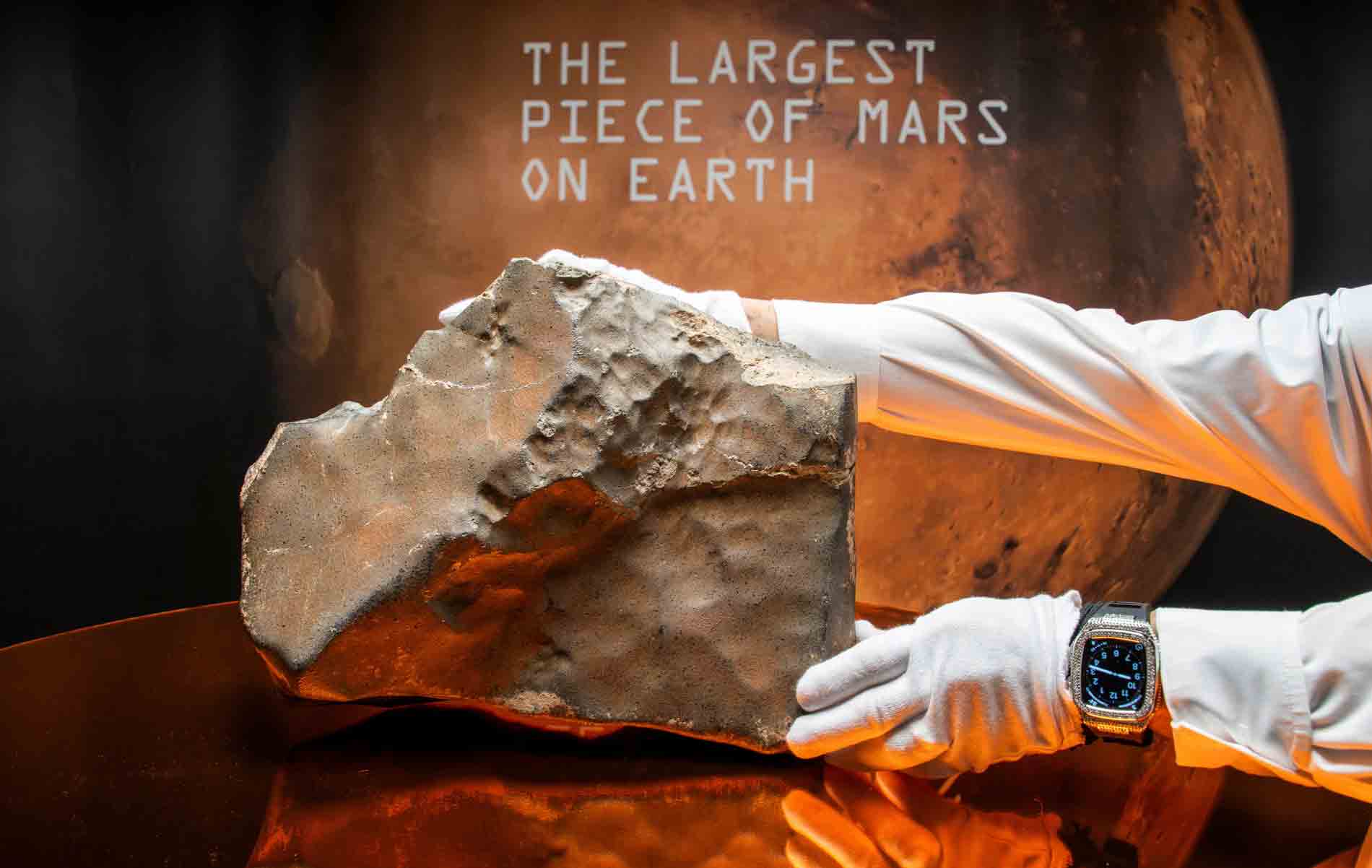New York — In an extraordinary auction that brought together rare relics from space and Earth, the largest piece of Mars ever discovered on Earth was sold for $5.3 million at Sotheby’s in New York. The 54-pound Martian meteorite, named NWA 16788, stunned collectors, scientists, and enthusiasts alike as it dramatically exceeded its pre-auction estimate of $2–$4 million.
This record-breaking sale was a highlight of Sotheby’s Geek Week 2025, an annual showcase of natural history treasures, including meteorites, fossils, and rare minerals.
A 140 Million-Mile Journey from Mars to Earth
The Martian meteorite was discovered in November 2023 in the Sahara Desert in Niger by a meteorite hunter. Scientists believe the rock was launched off the surface of Mars by a powerful asteroid impact, sending it on a staggering 140 million-mile journey through space before eventually landing on Earth.
“This Martian meteorite is the largest piece of Mars we have ever found by a long shot,” said Cassandra Hatton, vice-chairman for science and natural history at Sotheby’s. “It’s more than double the size of what we previously thought was the largest piece of Mars.”
A Rare and Scientifically Significant Find
There are fewer than 400 confirmed Martian meteorites among the over 77,000 meteorites discovered on Earth, making this specimen extremely rare. Even more remarkable, NWA 16788 is over 70% larger than any previously recorded Martian meteorite and makes up nearly 7% of all Martian material on Earth.
The rock measures nearly 15 x 11 x 6 inches (375mm x 279mm x 152mm) and displays a distinctive red, brown, and gray coloration.
Scientific analysis revealed that the meteorite is an olivine-microgabbroic shergottite, a type of volcanic rock formed from the slow cooling of Martian magma. The specimen also features a glassy outer surface, likely a result of the intense heat it experienced while entering Earth’s atmosphere.
From Rome to New York: A Meteorite’s Journey
Before making its way to the auction block, the meteorite was on display at the Italian Space Agency in Rome. Sotheby’s confirmed its Martian origin by comparing its unique chemical composition with those of other Martian meteorites, particularly samples studied by NASA’s Viking spacecraft that landed on Mars in 1976.
The auction began with two advance bids at $1.9 million and $2 million. As bidding proceeded, the pace was slower than expected, prompting the auctioneer to reduce bid increments from $300,000 to $100,000. Eventually, the hammer fell at $4.3 million. After fees, the final sale price reached $5.3 million. The buyer has not been publicly identified.
Jurassic Giant: Dinosaur Skeleton Fetches $30.5M
While the Martian meteorite drew attention, another colossal highlight was the sale of a juvenile Ceratosaurus nasicornis skeleton, which fetched a jaw-dropping $30.5 million including fees—vastly exceeding its $4M–$6M estimate.
The Jurassic-era skeleton was unearthed in 1996 near Laramie, Wyoming, at the famous Bone Cabin Quarry. The specimen includes nearly 140 fossilized bones, meticulously assembled and mounted for exhibition. Standing over 6 feet tall and stretching nearly 11 feet long, the dinosaur is believed to have lived 150 million years ago during the Late Jurassic period.
The Ceratosaurus was a bipedal predator with short arms, somewhat resembling the Tyrannosaurus rex, though smaller. The fossil was acquired by Fossilogic, a Utah-based company that specializes in fossil preparation and exhibition.
What Makes Martian Meteorites So Valuable?
Martian meteorites are priceless to scientists because they offer the only natural samples from the surface of Mars available on Earth. These meteorites help researchers understand Martian geology, volcanic activity, and even the potential for past life.
Testing indicates that NWA 16788 was likely ejected from Mars relatively recently in geological terms, though an exact timeline remains unclear.
The meteorite’s mineral content, structure, and heat fusion crust all point to its interplanetary origin. The presence of olivine and pyroxene—minerals commonly found in volcanic rocks—further confirmed its identity.
A Growing Market for Scientific Wonders
The sale of NWA 16788 marks a significant moment not just for Sotheby’s, but for the rising demand in space-related collectibles. Meteorites, once mainly studied by academics and planetary scientists, are increasingly sought after by private collectors, museums, and investors.
Sotheby’s Geek Week 2025 featured 122 objects, including lunar meteorites, asteroid fragments, fossilized insects in amber, and gem-quality minerals. The success of this year’s event suggests that natural history auctions are becoming big business.
Conclusion: A Piece of Mars in Private Hands
The record-breaking sale of the largest Martian meteorite ever found on Earth is a testament to the growing fascination with space, science, and the mysteries of the universe. For $5.3 million, one lucky (and wealthy) collector now owns a literal piece of another planet.
Meanwhile, the $30.5 million dinosaur sale proves that the past—whether from prehistoric Earth or the distant Red Planet—continues to captivate minds and open wallets. Whether for science, investment, or sheer wonder, the cosmos and its relics are closer than ever.
Stay up to date with the latest news. Follow Yalla TV on WhatsApp Channels.





